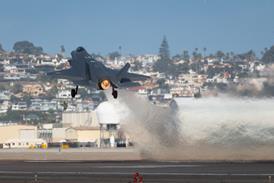Boeing expects to deliver the first 737-700 equipped with a fuel tank flammability reduction system (FRS) on 13 December and was completing flight-certification tests on the first aircraft late last week.

The work follows the recent start of a six-month in-service evaluation of the first FRS-equipped 747-400, and comes on the heels of a notice of proposed rule making (NPRM) issued on 14 November by the US Federal Aviation Administration calling for a fuel-tank inerting system to be installed on all US-registered airliners by 2012. Boeing, which also plans to deliver the second FRS-equipped 737 and 747 to customers over the next few days, says the effort is part of a campaign to field inerting systems for all its commercial models between 2006 and 2008.
The developments follow the 1996 crash of a TWA 747, which was determined to have been caused by a centre fuel tank explosion, and by the destruction on the ground of two 737s due to fuel tank explosions in 1990 and 2001.
In place of the heavy and expensive dedicated inerting systems first proposed to counter the flammability risk of partially empty fuel tanks, the FRS uses bleed air ducted to air separation modules that remove around 50% of the oxygen. The bleed air is then mixed with air from a nitrogen generating system to feed the fuel tank with virtually inert, nitrogen rich air.
Following earlier tests in 2002, the FAA determined that an oxygen level of 12% is sufficient to prevent ignition, rather than the 10% previously assumed. This was a key breakthrough as it virtually halved the size of the required inerting system, making it commercially viable. Boeing says the 12% level is achievable with one FRS air separation module on the 737, but that the 757/767 will require up to four, the 747 five and the 777 six. Although only one is required for all phases of flight on the 737, the much larger tanks and fuel system of the 747 requires the use of one module for climb and cruise, and all five in descent when the flammability risk is highest. The 787 is the first Boeing aircraft to be designed with an in-built fuel-tank inerting system from the outset and will therefore not require modification to meet the forthcoming ruling. Boeing flight tested a prototype FRS system developed by Honeywell and Parker Aerospace on a 747-400 in mid-2003, and flight tested a scaled-down version on a Next Generation 737 in 2004.
GUY NORRIS/LOS ANGELES
Source: Flight International























